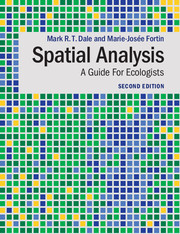Book contents
- Frontmatter
- Dedication
- Contents
- Preface
- 1 Spatial concepts and notions
- 2 Ecological and spatial processes
- 3 Points, lines and graphs
- 4 Spatial analysis of complete point location data
- 5 Contiguous units analysis
- 6 Spatial analysis of sample data
- 7 Spatial relationship and multiscale analysis
- 8 Spatial autocorrelation and inferential tests
- 9 Spatial partitioning: spatial clusters and boundary detection
- 10 Spatial diversity analysis
- 11 Spatio-temporal analysis
- 12 Closing comments and future directions
- References
- Index
8 - Spatial autocorrelation and inferential tests
Published online by Cambridge University Press: 05 September 2014
- Frontmatter
- Dedication
- Contents
- Preface
- 1 Spatial concepts and notions
- 2 Ecological and spatial processes
- 3 Points, lines and graphs
- 4 Spatial analysis of complete point location data
- 5 Contiguous units analysis
- 6 Spatial analysis of sample data
- 7 Spatial relationship and multiscale analysis
- 8 Spatial autocorrelation and inferential tests
- 9 Spatial partitioning: spatial clusters and boundary detection
- 10 Spatial diversity analysis
- 11 Spatio-temporal analysis
- 12 Closing comments and future directions
- References
- Index
Summary
Introduction
Parametric statistics are based on the assumption of independence of the errors given the statistical model to be fitted, such as linear regression. When performing parametric tests with ecological data, the assumption of independence of the errors is often violated, increasing the Type I error and biasing the estimation of regression parameters (Diniz-Filho et al. 2003; Dormann et al. 2007; Bini et al. 2009; Diniz-Filho et al. 2009; Beale et al. 2010). The lack of independence in the errors (see also Chapter 12) can arise because objects (samples, observations, etc.) that are closer together sometimes have a tendency to be more similar than those that are further apart (see Chapters 1, 2 and 6). This lack of independence can be due to spatial, temporal and phylogenetic processes (Ives & Zhu 2006; Peres-Neto 2006). Here we focus only on spatial dependency that generates spatially autocorrelated data. One source of spatial autocorrelation in the data can be causal interactions within the measured variable itself; for example, in studying species distribution and abundance, the abundance of a single species may be spatially autocorrelated because of constraints on the organisms’ mobility and dispersal. This kind of autocorrelation is sometimes called ‘true autocorrelation’, but we suggest it would be better referred to as ‘inherent autocorrelation’ (Chapters 1 and 2). This descriptor is to distinguish this phenomenon from ‘induced spatial dependence’ where the observed variable (e.g. species abundance) has a functional dependence on an underlying variable (e.g. soil moisture or nutrient content) that is itself autocorrelated (cf. Legendre et al. 2002). It may not be easy to distinguish between the two in ecological studies, and both may occur together in a single example (Wagner & Fortin 2005). In fact, for many types of ecological study, it is common for both the biological response variable and an underlying environmental factor to be spatially autocorrelated. The presence of spatial autocorrelation in the dependent variable (hereafter the response variable, y), in the independent variables (hereafter covariate or predictor variables, x), or in both types of variables in an inferential framework, will affect both the parameters’ estimation accuracy and the power of the significance test.
Information
- Type
- Chapter
- Information
- Spatial AnalysisA Guide For Ecologists, pp. 206 - 243Publisher: Cambridge University PressPrint publication year: 2014
